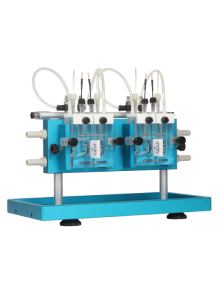Ussing Chamber System (Software included)
- Product Code: 125784
an essential tool for studying the transport and absorption of drugs across epithelial tissues, such as those in the intestines, skin, and respiratory tract
Ussing Chamber System (Software included)
an essential tool for studying the transport and absorption of drugs across epithelial tissues, such as those in the intestines, skin, and respiratory tract
Ussing chamber is an essential tool for studying the transport and absorption of drugs across epithelial tissues, such as those in the intestines, skin, and respiratory tract. Here's how the Ussing chamber is utilized in drug development:
1. Assessing Drug Absorption and Permeability:
- Intestinal Absorption Studies: The Ussing chamber allows researchers to simulate the conditions of the gastrointestinal tract by using segments of intestinal tissue. This setup helps evaluate the absorption of oral drugs. By measuring the transport of drugs from the mucosal side (representing the intestinal lumen) to the serosal side (representing the bloodstream), scientists can determine the permeability of a drug across the intestinal epithelium.
- Blood-Brain Barrier Studies: For drugs intended to affect the central nervous system, it's crucial to understand their ability to cross the blood-brain barrier. The Ussing chamber can be used with tissue samples that mimic the properties of this barrier to study drug permeability.
2. Mechanistic Studies of Transporters and Efflux Pumps:
- Transporter Interaction: Many drugs interact with specific transporters in epithelial cells, such as P-glycoprotein (P-gp), which can affect their absorption and bioavailability. The Ussing chamber helps study how drugs are transported across tissues and whether they are substrates or inhibitors of these transporters.
- Efflux Pump Characterization: Efflux pumps can limit the intracellular concentration of a drug by actively transporting it out of cells. The Ussing chamber can help identify drugs that are substrates for these pumps, which is important for understanding drug resistance, especially in cancer therapy.
3. Evaluating Mucosal Irritation and Toxicity:
- Toxicity Assessment: Before a drug is approved for use, it's crucial to evaluate its safety. The Ussing chamber can help assess the toxicological impact of a drug on epithelial tissues, such as the intestinal lining, by measuring changes in transepithelial electrical resistance (TEER) and permeability, which indicate damage or irritation to the tissue.
4. Optimizing Drug Formulations:
- Enhancing Drug Delivery: By studying the transport properties of different formulations, researchers can optimize drug delivery systems. For example, in developing oral formulations, the Ussing chamber can help identify excipients or additives that enhance absorption or reduce degradation in the gastrointestinal tract.
- Controlled Release Studies: The Ussing chamber can also help assess the release rate of drugs from formulations like nanoparticles, liposomes, or hydrogels, providing data on how effectively these formulations deliver the drug across epithelial barriers.
5. Modeling Disease States for Drug Efficacy:
- Disease Models: Ussing chambers can be used with tissues from disease models to study drug efficacy under pathological conditions. For example, tissues from animal models of inflammatory bowel disease can be used to evaluate the potential therapeutic effects of new anti-inflammatory drugs.
6. Studying the Effects of Drug Metabolites:
- Metabolite Analysis: The Ussing chamber can also be used to study the permeability and effects of drug metabolites, which might differ significantly from the parent drug in terms of absorption, efficacy, and toxicity.
7. Investigation of Drug-Drug Interactions:
- Interaction Studies: The Ussing chamber allows researchers to study potential drug-drug interactions at the epithelial barrier, such as how one drug might affect the absorption or metabolism of another when both are present in the gastrointestinal tract.
Benefits of Using Ussing Chambers in Drug Development:
- Controlled Environment: The Ussing chamber provides a controlled environment to study specific variables, allowing researchers to isolate the effects of the drug on epithelial transport.
- In Vitro Insights: It offers an in vitro approach that can reduce the need for early-stage animal testing and provide preliminary data on drug behavior in human-like conditions.
- Translational Relevance: Data obtained from Ussing chamber studies can be highly predictive of in vivo drug absorption and bioavailability, aiding in the translation of preclinical findings to clinical settings.
| Mechanism | - |
| Appearance | - |
| Longevity | - |
| Strength | - |
| Storage | - |
| Shelf Life | - |
| Allergen(s) | - |
| Dosage (Range) | - |
| Recommended Dosage | - |
| Dosage (Per Day) | - |
| Recommended Dosage (Per Day) | - |
| Mix Method | - |
| Heat Resistance | - |
| Stable in pH range | - |
| Solubility | - |
| Product Types | - |
| INCI | - |
Purchase History for
Loading purchase history...
Cart
No products
Subtotal:
฿0.00
฿0.00
Total :






